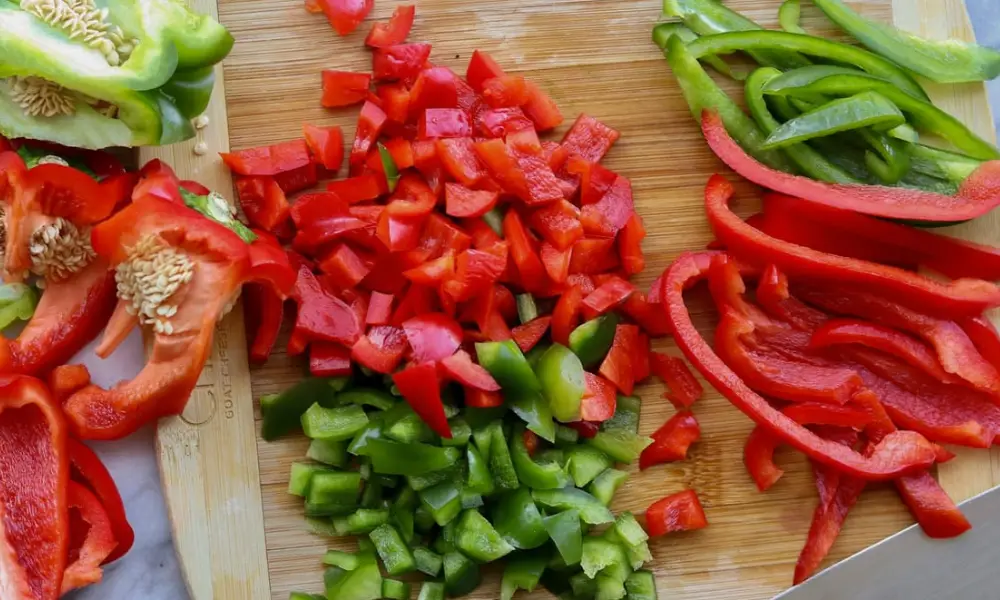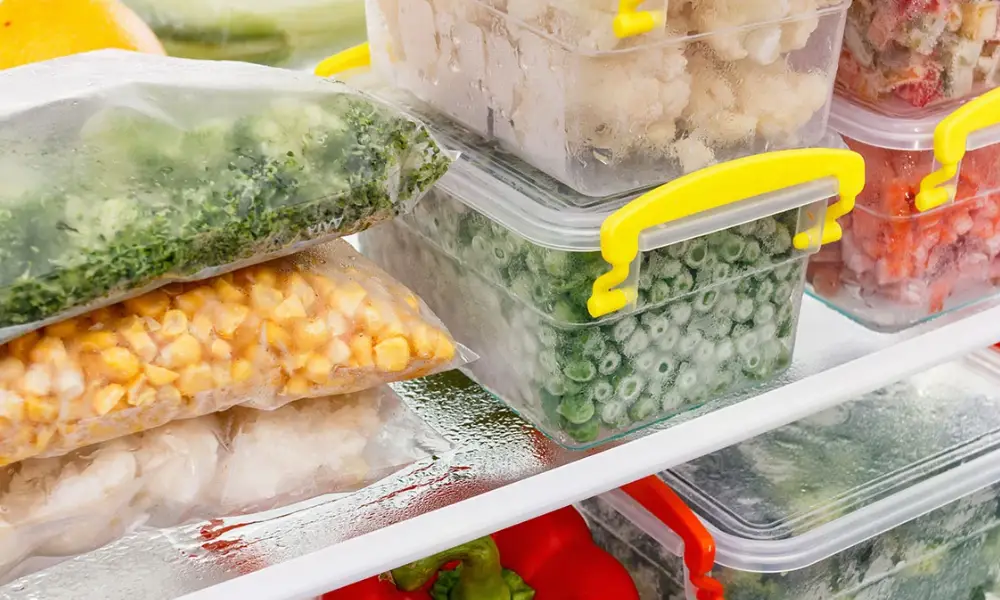Your favorite vegetables must first be blanched before freezing by inhibiting the enzymes that cause the vegetables to lose their bright color and prevent rotting. Without blanching, vegetables will lose color, become dull, and change in texture. Additionally, it stops them from losing their nutrients and flavor. Several advantages of blanching fresh vegetables are listed below.

How to Freeze Fresh Vegetables?
Generally, vegetables that hold up well to cooking (like corn and peas) freeze nicely. Vegetables should first be lightly blanched in boiling water before being frozen. Then, to keep the vegetables from cooking, swiftly immerse them in icy water. Dry completely on sheet pans lined with paper towels. Learn more about blanching and shock-cooking veggies.
Vegetables can be frozen fast by being placed on a sheet pan with a rim. When the food is completely frozen, please keep it in freezer bags or airtight containers. Remove as much air as possible from freezer bags and fill hard-sided containers. Date the packages, please.
Potatoes
You should wash and peel your potatoes. I quartered them after that and blanched them for three to five minutes. After putting them in the ice bath for 5 to 10 minutes, cut them into the desired size. Remove as much air as possible before placing it in a freezer bag.
Broccoli
On a plate or sheet tray covered with parchment paper, arrange the broccoli in a single layer. Place in freezer and let there for 1 to 2 hours, or until totally firm. After being frozen, put in a plastic container or freezer bag that can be sealed. The broccoli should retain its fresh flavor for six to eight months and be free of freezer burn.
Bell Peppers and Onions
Bell peppers and onions, chop your onions however you like, and for the peppers, remove the membranes, seeds, and stems before cutting them however you prefer. Please place them in the freezer until hard, then move them to a vacuum-sealed bag or a freezer-safe zip-top bag with all the air squeezed out. After that, spread them out on a tray, so they don’t touch.
Carrots
Carrots are Cut into lengthwise strips, 1/4-inch cubes, or thin slices. Small whole carrots should be blanched for five minutes, chopped or sliced for two minutes, and lengthwise strips for two minutes. Quickly cool, drain, pat dry, and package with a half-inch headspace. Enclose and freeze. Use only fresh carrots; else, the flavor of the cooked carrots will be rubbery. They’ll remain edible for a whole year.
Celery
Celery is one of the vegetables that won’t freeze nicely. It might not maintain its color and be limp.
If you want a crunchy snack or to give a pasta salad some crunch, this is not a good thing. However, having pre-chopped celery on hand and prepared to add to soups, cooked casseroles, or sauteed meals is a terrific alternative if you want to add celery taste to those recipes. Trim the celery stalks, blanch for three minutes, and then proceed with the recipe. You can chop them finely before freezing them or chop them finely before adding them to a dish. They can last up to a year in your refrigerator.
Cucumbers
Cucumbers can be frozen using four different techniques: the brine method, the ice cube method, and the purée method.
Clean those cucumbers first, before anything else. Cucumbers picked from the garden or locally produced need to be rinsed with water; however, unwrapped cucumbers from stores may have a wax covering that needs to be removed with water and vegetable wash. As a tip, mix 1 cup vinegar, 4 cups water, and one tablespoon lemon juice in a spray bottle to create your vegetable wash. Cucumbers should be placed in a strainer or colander, sprayed, and allowed to sit for two to five minutes before being rinsed or scrubbed with a vegetable brush.
Freeze the Asparagus
Nearly finished! To freeze asparagus effectively, adhere to these easy steps:
- You can use the frozen asparagus whole or cut it into smaller pieces depending on how you intend to use it later.
- On a baking sheet, arrange the asparagus in an equal layer. The baking sheet should be covered and frozen for at least two hours.
- Transfer the frozen asparagus into freezer bags with the date written on them. They’ll be usable for eight to twelve months.
Packaging for the Freezer
Fruits and vegetables must be packed with moisture within and the air outside for successful freezing. Changes in flavor and color might result from contact with air. Fruits and vegetables should be placed in airtight containers or moisture-proof, strong freezer bags, with as much air squeezed out as possible. The heavy-duty foil should be used to wrap and freezer tape to seal freezer bags. Avoid using plastic sandwich bags because they aren’t sturdy enough.
Set the freezer to its coldest setting a few hours before adding food. Likewise, don’t overfill the freezer (it will slow the freezing process).
Preparing Vegetables for the Freezer
Salads and vegetables with high water content, like cucumbers, cannot be frozen. Nearly everything else can. No woody roots or stringy beans, please! Only produce that is in good shape and that you wouldn’t mind eating fresh should ever be frozen.
To preserve produce’s peak freshness, harvest it as close to freezing as possible. Process them in batches to get your freshly picked fruits and veggies into the freezer as quickly as possible.
The freezer is stocked with beans, peas, and other high-sugar veggies like sweet corn and young carrots. After trimming the ends of the beans, divide larger beans in half. If space is an issue, pluck the corn kernels from the cob beforehand because whole cobs of corn take up a lot of space. A neat and orderly method for doing this is to use a knife to carefully pry out the first row of kernels before gently pushing out each succeeding row of kernels with only your fingertips. By preserving the full kernel, this technique reduces waste.
How to Blanch Vegetables?
Most veggies must be blanched before frozen (fruits and berries do not). Several reasons exist for blanching, which involves scorching vegetables in hot water before freezing them:
To sterilize the surface of the produce, removing dirt and pathogens, prevent enzymes from affecting the color and flavor of the food, and stop the loss of nutrients in the product
Although blanching vegetables is simple, using the appropriate amount of time is crucial. If not, their quality can be impacted. Consult this list of blanching times from the National Center for Home Food Preservation to determine how long to blanch your vegetables.
Here’s how to blanch your vegetables:
- Bring water in a big pot lightly salted to a roaring boil. Prepare a bowl of ice water at the same time to place the vegetables in after they have been scalded.
- Vegetables should be added in tiny batches to the water, which should be brought back to a boil rapidly.
- The blanching process starts as the water reaches a boil again.
- To determine how long your vegetables should be blanched, refer to this list. Small vegetables like peas should only be blanched for one minute, beans should be blanched for about two minutes, and sliced entire veggies like carrots should be blanched for three to four minutes.
- The blanched veggies should be taken out of the boiling water and placed in a dish of ice water. This puts an end to cooking.
- Dry off your vegetables after blanching. They are now prepared to be placed in freezer bags or containers and frozen!
- It’s time to preserve your vegetables after it has been adequately blanched.
Tips:
- For the finest flavor and texture after freezing, freeze vegetables as soon as possible after picking or purchasing them. For freezing, choose items that don’t have any nicks or bruises.
- Almost all vegetables must be blanched, briefly submerging them in steam or boiling water. Blanching removes dirt and germs from the surface, enhances the color, and helps prevent vitamin loss. It halts enzyme reactions that may result in flavor, color, and texture loss. Additionally, it softens or wilts veggies, making them easier to pack.
- The length of time needed to blanch a vegetable depends on its size. Underblanching is worse than no blanching since it increases the activity of enzymes. Loss of flavor, color, vitamins, and minerals results from over boiling. For every pound of prepped vegetables, use one gallon of water. In a blanching basket, place the vegetable, and lower it into a pot of rapidly boiling water. Give the blancher a lid. If it takes longer than a minute for the water to re-boil, you are using too many vegetables about the amount of boiling water. As soon as the water returns to a boil, begin timing the blanching process. Keep the heat on high for the duration specified in the instructions for the vegetable you are freezing.
- Leave the tops of the bags with a 12 in-1 inch gap.
Can You Freeze Raw Vegetables?
Vegetables can be prevented from discoloring and becoming mushy by blanching them or plunging them into boiling water. Unless they are onions or peppers, which can be frozen raw, vegetables should be blanched or fully cooked before freezing. On the other hand, raw fruit freezes without any issues.
All vegetables except celery, watercress, endive, lettuce, cabbage, cucumber, and radishes can be frozen. Since these meals contain a lot of water, thawing them makes them soggy and water-logged.
What Vegetables do not Need Blanching?
Vegetables can be prevented from discoloring and becoming mushy by blanching them or plunging them into boiling water. Unless they are onions or peppers, which can be frozen raw, vegetables should be blanched or fully cooked before freezing. On the other hand, raw fruit freezes without any issues.
How to Freeze Vegetables in Containers?
Fill freezer bags or containers with cold vegetables, remove extra air, and freeze. Only freeze up to 1.5 kg (3 lbs) at a time for optimal results. A lot of vegetables can be frozen in separate portions. Spread out on a shallow pan, freeze for 1 hour or until hard, and then pack in freezer containers.
Are Cucumbers Still Good if They Freeze?
The best way to store and enjoy cucumbers all year round is to freeze them. Instead of freezing whole cucumbers, which become soggy and lose their flavor when defrosted, it is preferable to freeze cucumber slices. If you properly prepare them, cucumbers can be stored in the freezer for six to nine months.
Conclusion
Most veggies can be kept in your refrigerator as-is, although some vegetables are better kept in a salad drawer, crisper, or cloth bags. If properly preserved, vegetables can last for up to a month. Longer storage times will impair the nutritional value of the vegetables because they require a temperature range of 50 to 70 degrees in these storage containers. Vegetables were once kept in soil. Fresh veggies can now be kept in a temperature-controlled space with ease.
